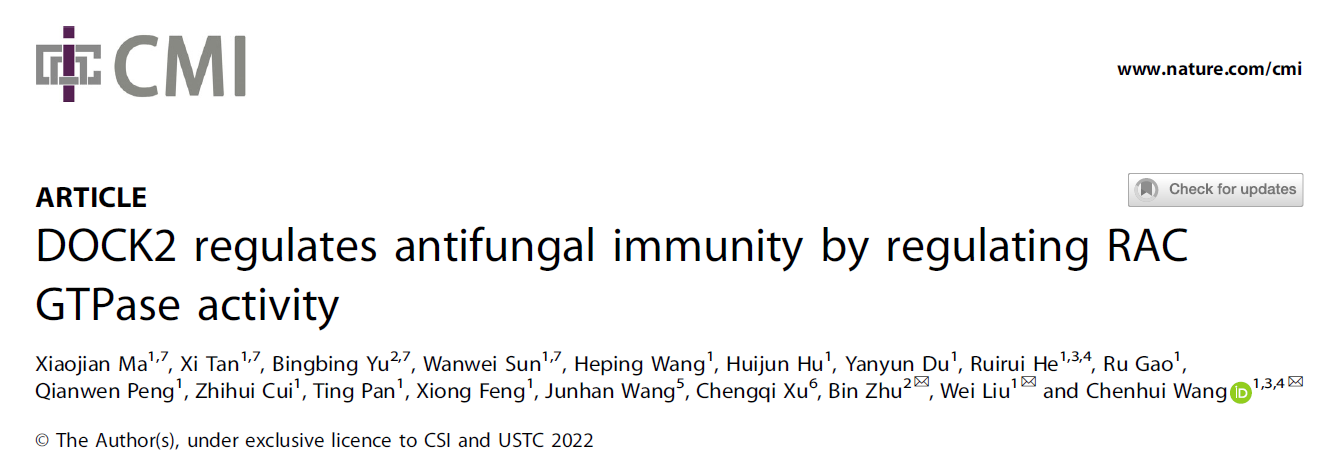(Correspondent Ma Xiaojian) on January 26, Professor Wang Chenhui's team from school of life, Huazhong University of science and technology published a research paper entitled "DOCK2 regulated antifungal immunity by regulating RAC GTPase activity" in cellular molecular immunology, an authoritative journal of immunology.

In recent years, fungal infection is on the rise all over the world and has become one of the important diseases endangering human health. The impact of fungal infection on human health is currently spiraling. The global mortality rate exceeds that of malaria or breast cancer, and is comparable to the deaths caused by tuberculosis and HIV infection. However, there are relatively few antifungal drugs (only 4 kinds of medicine are used clinically), which brings great challenges to the control of fungal infection. In addition, the research on antifungal immunity is not very sufficient, and there are many scientific problems in this field that need in-depth research. Professor Wang Chenhui's research group found that TAGAP protein is an important connector protein in the antifungal natural immune signal pathway and participates in the regulation of Th17 cell differentiation in the acquired immune system (NAT commun. 2020, APR 20; 11 (1): 1913). The follow-up study of the research group found that the interaction protein EphB2 of TAGAP is a co-receptor of Dectin-1 signaling pathway, which cooperates with Dectin-1 to recognize fungal cell wall components β-Glucan, and mediates antifungal innate immune signal transduction (J Immunol. Cutting edge, 2021, APR 1; 206 (7): 1419-1423). MYO1F is an interacting protein of TAGAP. The follow-up study of the research group found that MYO1F participates in antifungal innate immunity by regulating microtubule acetylation, and found that sirt2 deacetylase inhibitor can promote antifungal immunity, providing clues and drug precursors for antifungal immunotherapy (Proc Natl Acad Sci U S A. 2021 Jul 27; 118 (30): e2100230118).
DOCK2 is mainly expressed in immune cells. It is known that DOCK2 is involved in the movement and migration of immune cells. It has also been found that DOCK2 is involved in antiviral and anti-bacterial immunity, but it is unclear whether DOCK2 plays a role in antifungal immunity. We previously identified that DOCK2 was a interaction protein of MYO1F through mass spectrometry, suggesting that DOCK2 may also be involved in antifungal immunity. Through the study, we found that after fungal stimulation, tyrosine at 985 and 1405 of DOCK2 was phosphorylated by Syk, and phosphorylated DOCK2 mediated the activation of downstream RAC and the production of reactive oxygen species. We have proved that the production of reactive oxygen species mediated by DOCK2 is very important for the clearance of intracellular fungi and downstream signal transduction. More importantly, we delivered Rac1 mRNA specifically to monocyte macrophages through nano liposome mediated in vivo delivery, which promoted the activation of antifungal immunity, and had significant protection against mouse mycoemia. The innovations of this work are as follows: 1) we identified that DOCK2 is involved in antifungal immunity and its molecular mechanism of regulating antifungal immunity; 2) In vivo delivery of Rac1 mRNA mediated by nano liposomes provides clues for the treatment of antifungal infection. This study also provides a new concept for the treatment of anti-infectious diseases, that is, to promote the activation of specific anti infectious immune pathways through the delivery of specific mRNA molecules in vivo, so as to eliminate pathogens. Considering the increasing maturity of mRNA in vivo delivery technology, this concept can also be extended to the treatment of a variety of diseases.

PhD students Ma Xiaojian, Tan Xi, Yu Bingbing and postdoctoral sun wanwei, from the school of life of Huazhong University of science and technology, are the co-first authors of the paper. Huazhong University of science and technology is the first unit of the paper. Professor Zhu bin, Professor Liu Wei and Professor Wang Chenhui from the school of life, Huazhong University of science and technology are the co-corresponding authors of this article. This research is supported by the key Research and Development plan of the Ministry of science and technology, the National Natural Science Foundation of China, the National Postdoctoral fund and other fundings.
Link:https://www.nature.com/articles/s41423-021-00835-0